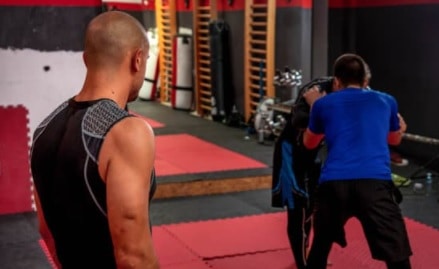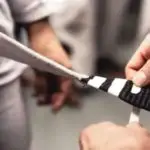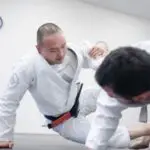Running too hard on the knees? Does the gym feel lifeless and stale, I mean, who wants to stand in front of the mirror doing curls anyways? Evening walks not doing it for you anymore? Maybe you’re considering alternative ways to get more fit. Or maybe you’re wondering what this new martial art is doing for you. In this article, I intend to inform you of how BJJ makes you fit.
Brazilian Jiu-Jitsu can burn 700-1100 calories while working your cardiovascular system, muscular endurance, isometric strength, grip strength, and core strength. It incorporates both anaerobic and aerobic exercises, known to help lose fat and build a strong heart and lungs. Additionally, it will bring you into a community that’ll help encourage you along the way, while the belt system may be the motivation you need to keep showing up.
Does BJJ Make You Fit?
Jiu-Jitsu will make you fit. It works the cardiovascular system, muscle endurance and isometric strength, grip strength, core strength, and overall works the entire body depending on the game plan and style used. It’ll help you lose weight (as long as your diet is in check too), improve your cardio, and develop an overall fit body, especially for Jiu-Jitsu.
Your cardio will improve from the constant bursts of energy required to pass, escape, or progress your position. These types of actions require a lot of energy to complete, which takes more oxygen, which in turn increases your heart rate.
Muscular endurance and isometric strength will increase. There are a lot of static holds (isometric) in Jiu-Jitsu. Whether it is framing to prevent someone from passing your guard, holding onto someone in your guard, or keeping your stomach tight from the big guy with his knee on your stomach, your muscles will be statically engaged.
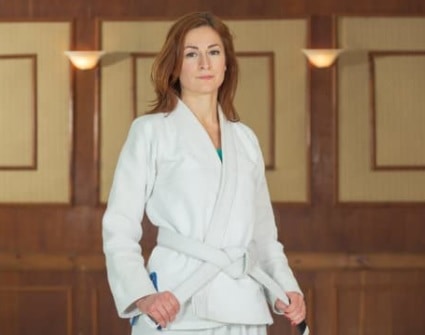
Muscle endurance comes from the constant pulling and pushing that occurs during a roll. Jiu-Jitsu does use a lot of leverages to assist in taking away giant strength requirements; however, you’re still going to build muscular endurance from all the actions that happen.
Two of the biggest things you’ll notice in Jiu-Jitsu is that your grip and core strength will increase.
Jiu-Jitsu has many grip battles, one could argue there is always a grip-battle occurring. You’ll almost always be holding onto your opponent whether it is on their sleeve, leg, collar, or back. Additionally, while you’re holding onto your opponent they’ll be fighting to get the grip off providing resistance to your muscles.
Your core will get stronger in many ways as well. For example, bright or bracing your stomach when someone puts their body weight on you will increase your core strength tremendously.
Will Jiu-Jitsu Make Me Ripped?
Unfortunately, BJJ by itself will not make you ripped. It does not provide enough resistance for muscles to grow like they would with a hypertrophy based workout. However, it will help you lose fat and build a more toned body that could give you a more athletic aesthetic.
Do You Need To Be In Shape Before Starting Jiu-Jitsu?
There are many people that may be intimated to start Jiu-Jitsu if they are out of shape. You do not need to be in shape before starting Jiu-Jitsu. There are people of all shapes and sizes, and various fitness levels in Jiu-Jitsu at all belt ranks. A lot of them even started Jiu-Jitsu to become more fit!
I know from personal experience that being in shape did not help me do better against others or prevent me from ‘gassing’ out. I remember in my second class I was so gassed out I had to tap! I’ll never forget that moment and I quickly learned to pace myself to my own fitness level.
There is another student that has been coming to class. He is in his late 40’s and over 300lbs. He started Jiu-Jitsu not able to do the rolling session of class. Eventually form the technique practice and drilling he soon was able to roll with 1 or 2 people. And now, after a year he is able to complete the entire rolling session in class!
It’s never to late to start and you’ll never be in shape for Jiu-Jitsu until you start doing Jiu-Jitsu – nothing can fully prepare you.
Here is a video form my favorite Jiu-Jitsu YouTube channel about if you should start Jiu-Jitsu if you’re out of shape. The quick answer is, yes you should start it!
How Many Calories Does Jiu-Jitsu Burn?
Jiu-Jitsu, or any type of grappling, burns a lot of calories. Through an entire BJJ class, you can expect to burn up to 700-1100 calories. For example, a 170lb male rolling (grappling) for 15 minutes can burn 150-170 calories. And that’s just the rolling session of class.
| Rolling Light | 3.25 calories burned per hour, per pound of body weight |
| Rolling Intense | 4.87 calories burned per hour, per pound of body weight |
Does Jiu-Jitsu Count As Cardio?
Jiu-Jitsu is unique in that it incorporates both aerobic and anaerobic cardio systems. Because of this, Jiu-Jitsu is an excellent cardio exercise. Cardio helps prevent or manage high blood pressure, heart disease, and diabetes.
Taking your cardio to the next level will require doing more than just BJJ. It is true the more you roll the better your cardio will be for rolling, but to progress even further it is important to include more than just BJJ.
Remember, as you roll more your technique gets better and you use less energy. Thus, adding cardio will allow you to continue improving your cardio.
I have an article of the 5 best cardio exercises for BJJ, if you need ideas for what cardio exercises feel free to give it a read – and yes, I’ve tested and tried them!
What Is Aerobic Exercise?
Aerobic exercise means “with oxygen.” Aerobic exercise helps keep your heart, lungs, and circulatory system healthy. During an aerobic exercise, you can expect your breathing and heart rate to increase. Aerobic exercises will occur during sustained movements.
During Jiu-Jitsu the aerobic cardiovascular system is worked mostly in the top position when you are moving more freely to get a better position.
What Is Anaerobic Exercise?
Anaerobic exercises are performed at maximum effort for a short time – they involve quick bursts of energy. Anaerobic, unlike aerobic, means “without oxygen”. In practical terms, this means that anaerobic exercise is harder but shorter than aerobic exercise.
In Jiu-Jitsu this style of exercise occurs all the time and much more frequently than aerobic cardio. Much like sprinting, escaping from side control (typically) requires a quick burst of energy to be successful.
A single leg take-down or bridging and shrimping away to escape side control are examples of this. Bridging, quickly shrimping away, framing, knee shielding, and regaining guard is a fast procedure.
Is BJJ A Good Way To Lose Weight?
Jiu-Jitsu is a great, practical, and exciting way to lose weight. A Jiu-Jitsu class can burn up to 1100 calories, that’s an entire McDonald’s Big Mac combo! It can be scaled for each individual regardless of age, height, weight, or injuries. Jiu-Jitsu will teach you skills that can be used to defend you and your family, along with building a strong mentality.
The hardest part about losing weight is staying motivated and consistent. Jiu-Jitsu will bring you into a community that’ll help encourage you along the way while the belt system may be the motivation you need to keep showing up.
It will help you lose weight and get a more toned body while you’re at it. Or, maybe you’re just looking for a reason to allow you to eat that Big Mac!

Is Jiu-Jitsu Healthy?
Jiu-Jitsu offers many health benefits both physical and mental. It is a physical activity that uses your body and mind in learning/developing techniques and strategies against others while involving you in a positive community of people.
Learning Jiu-Jitsu will teach you a lot about yourself as you are constantly going to be challenged in your skills and will power. Every night you will learn or refine a technique and practice it with another student in the class.
Finally, you’ll have either situational drills to practice the new technique or an open roll to put all of the techniques you know to practice.
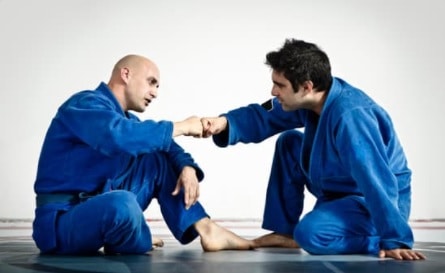
Jiu-Jitsu is a high-intensity martial art/sport that uses a lot of cardio. Improving your cardiovascular system helps prevent or manage high blood pressure, heart disease, and diabetes.
Cardio releases endorphins which gives your brain a “feel-good” chemical naturally. In addition to what you’ve accomplished in class, this release will be much higher and you can expect yourself to be in a great mood afterward!
Although there is a risk of injury in every Jiu-Jitsu class, Jiu-Jitsu is healthy. It brings people into a positive environment that new skills are then taught, and figured out. It uses the body which means you are getting a full-body workout every time you’re in class.
Conclusion
Jiu-Jitsu will help you become more fit. It’ll assist you in improving your cardiovascular system which in turn will allow you to incorporate other physical activities into your life. One Jiu-Jitsu class can burn as many as 1100 calories. Since Jiu-Jitsu uses some aerobic movements and a lot of anaerobic you will be burning lots of fat too.
Throughout your Jiu-Jitsu journey, you will notice that your muscular endurance has improved, grip and core strength increased, and overall mobility, flexibility, timing, balance, and perception much better!
